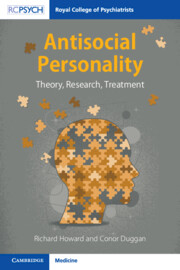Book contents
- Antisocial Personality
- Reviews
- Antisocial Personality
- Copyright page
- Contents
- Preface
- Chapter 1 The Nosological Background
- Chapter 2 Interpersonal Perspective
- Chapter 3 Developmental Perspective
- Chapter 4 Brain and Behaviour Perspective
- Chapter 5 The Epidemiology of Antisocial Personality Disorder
- Chapter 6 Treatment of ASPD, Part 1
- Chapter 7 Treatment of ASPD, Part 2
- Chapter 8 Legal and Ethical Issues in ASPD and Psychopathy
- Chapter 9 Conclusions and Future Directions
- Index
- References
Chapter 3 - Developmental Perspective
Published online by Cambridge University Press: 20 January 2022
- Antisocial Personality
- Reviews
- Antisocial Personality
- Copyright page
- Contents
- Preface
- Chapter 1 The Nosological Background
- Chapter 2 Interpersonal Perspective
- Chapter 3 Developmental Perspective
- Chapter 4 Brain and Behaviour Perspective
- Chapter 5 The Epidemiology of Antisocial Personality Disorder
- Chapter 6 Treatment of ASPD, Part 1
- Chapter 7 Treatment of ASPD, Part 2
- Chapter 8 Legal and Ethical Issues in ASPD and Psychopathy
- Chapter 9 Conclusions and Future Directions
- Index
- References
Summary
This chapter reviews what is known about the developmental antecedents of adult antisocial personality. It addresses the question of why it is that, while many people may have personality difficulties, a minority develop a severe and persistent dysfunction of personality that is more or less life-long, leading them into a pattern of chronic antisocial behaviour. Findings reviewed in this chapter suggest that the route to adult antisociality is marked by a cascade of developmental roadblocks and insults arising during childhood and adolescence. The authors emphasise the importance of adolescence as a period when things can go seriously awry and personality can deviate from a normal track. They further emphasise the critical importance of substance abuse, particularly the misuse of alcohol, in the genesis of life-course-persistent antisociality. Two possible developmental pathways are described, one predominantly male, the other predominantly female, through which adult antisociality results from adverse circumstances in childhood and adolescence.
- Type
- Chapter
- Information
- Antisocial PersonalityTheory, Research, Treatment, pp. 43 - 58Publisher: Cambridge University PressPrint publication year: 2022

